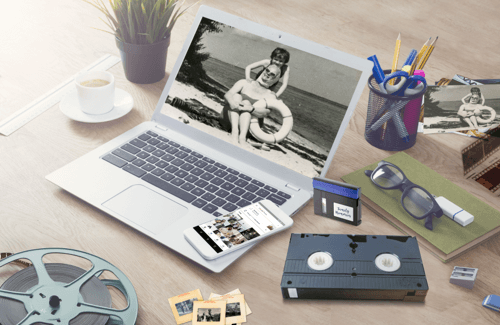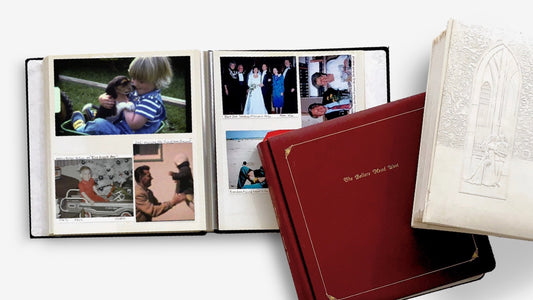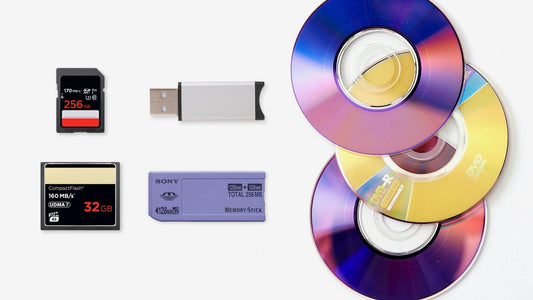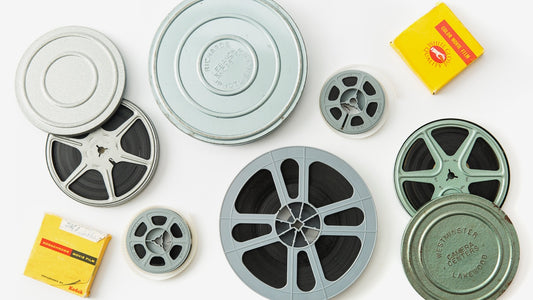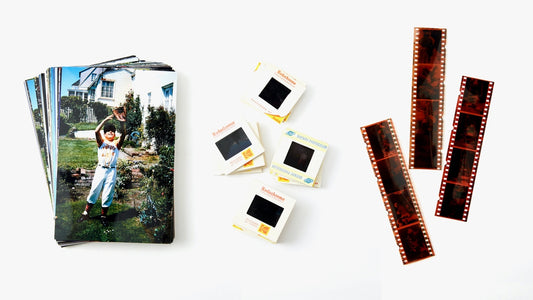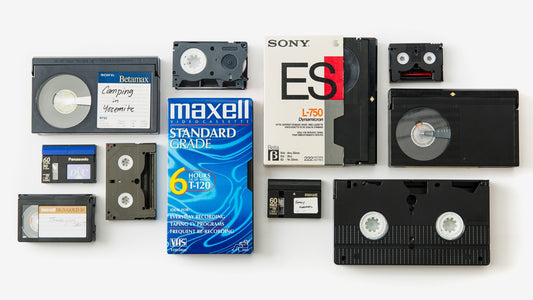The most important parts of your home movies are the sights and sounds of the people you love—a child’s first words, the laughter at a family reunion, the look on a bride’s face. When those moments are buried under a layer of visual static and audio hum, the emotional connection feels distant. The goal of video editing isn’t just to make things look technically better; it’s to bring that connection back to the forefront. By using noise reduction video techniques, you can peel back the layers of distraction to reveal the clarity and warmth of the original memory, making your videos a joy to watch and share all over again.
Key Takeaways
- Identify and Address Video Noise: That distracting fuzz and hum in old home movies are common issues caused by aging media and older technology, but they can be significantly reduced with the right tools or services.
- Choose Your Restoration Path: Whether you prefer a hands-on approach with user-friendly software or want to hand it off to experts for a professional finish, there's a straightforward way to clean up your digitized memories.
- Improve Future Recordings with Simple Steps: For new videos, you can prevent most noise issues by focusing on two key elements before you hit record: good lighting and a stable camera.
What Is That Fuzz and Hum in Your Videos?
Have you ever pulled out an old home movie, excited to relive a special moment, only to be met with a screen full of grainy fuzz and a distracting background hum? That’s video noise, and it’s a common issue with older formats like VHS tapes and 8mm film. It’s the visual and auditory clutter that gets in the way of your memories. Visually, it looks like a layer of dancing speckles or grain over the picture, making everything look a bit fuzzy. Aurally, it’s that persistent hiss, wind noise, or low hum that can drown out the voices of your loved ones.
The good news is that you're not stuck with it. Whether you're trying to clean up old family videos or improve new recordings, understanding what causes this noise is the first step. Many of these issues stem from the original recording conditions or the natural aging of the tapes themselves. Fortunately, modern tools can help reduce this noise, making your cherished moments clearer and more enjoyable to watch. If you'd rather leave it to the experts, professional video transfer services use advanced equipment to get the best possible quality from your original tapes, saving you the time and effort of learning new software.
Identifying Visual and Audio Noise
So, what exactly should you be looking and listening for? Visual noise, often called grain, shows up as random, flickering speckles across your video. It’s especially noticeable in darker scenes or areas with solid colors. Think of it as static on an old TV screen, but embedded in your video. This happens a lot with footage shot in low light.
Audio noise is just as disruptive. It can be a constant, low-frequency hum from electronic equipment, the hiss from the videotape itself, or the sound of wind rushing past the microphone during an outdoor birthday party. Sometimes, it’s just muffled background chatter that makes it hard to hear the main conversation. The process of removing unwanted noise is about isolating and reducing these distracting sounds so you can focus on what matters.
How Noise Affects Your Cherished Memories
A little bit of grain might add a nostalgic feel, but too much noise can be a real problem. That distracting background hum can easily pull you out of the moment, making it difficult to hear your child’s first words or a loved one's laugh during a family gathering. When the audio is muffled or overpowered by a hiss, the emotional connection to the memory can feel distant.
Similarly, excessive visual grain can obscure the very details you want to see—the expression on a bride’s face, the decorations at a holiday party, or the tiny features of a newborn baby. Bad background noise and visual clutter can make your videos feel less immersive and cause you to lose interest in watching them. Cleaning up these imperfections helps restore the clarity and emotional impact of your most precious moments.
Where Does Unwanted Noise Come From?
Unwanted noise can sneak into your videos from a few different sources. For visual grain, the culprit is often a lack of light. When you record in a dimly lit room, the camera's sensor has to work harder, which creates those grainy speckles. The quality of the camera itself also plays a big role; older camcorders and their sensors were simply not as advanced as today's technology.
Audio noise is one of the most common challenges in any recording. The built-in microphones on older cameras were notorious for picking up everything, from the whir of the camera's own motor to the wind blowing outside. Over time, the magnetic tape in formats like VHS and Hi8 can also degrade, which introduces more hiss and audio imperfections during playback. Understanding these common causes of noise can help you appreciate why your older videos might need a little help to look and sound their best.
Our Top Picks for Noise Reduction Software
Once you’ve digitized your home movies, you might notice some lingering graininess or a persistent background hum. The good news is you don’t need a Hollywood studio budget to clean it up. There’s a wide range of software out there designed to tackle these exact issues, from powerful, feature-rich programs to simple, one-click online tools. Finding the right one just depends on your technical comfort level and how much time you want to spend editing.
Of course, if you'd rather skip the editing process altogether, services like our video transfer can handle the heavy lifting for you, delivering a clean digital file ready for sharing. But if you enjoy a little DIY or want to fine-tune your memories yourself, we’ve gathered some of the best noise reduction software to help you get a clearer picture and sound. We’ll walk through options for every skill level and budget, so you can find the perfect fit for your project.
Powerful Software for a Professional Touch
If you’re aiming for the best possible quality and don’t mind a bit of a learning curve, professional-grade software is the way to go. These tools give you precise control over your video and audio, letting you dial in the perfect settings. For visual noise, Topaz Denoise AI is a standout choice that uses artificial intelligence to intelligently remove grain while preserving detail. Many creators also rely on the powerful tools built into Adobe Photoshop and Adobe Lightroom Classic, which offer robust tools for enhancing video quality. These programs are perfect for anyone who wants to achieve a polished, professional look for their treasured home movies.
Easy-to-Use Online Tools
Don't want to download or install anything? There are some fantastic browser-based tools that make noise reduction incredibly simple. For audio issues, Media.io offers a free online tool that can remove background noise from your video with just a single click. It’s perfect for getting rid of that distracting hum or hiss without getting bogged down in complicated settings. Another great option is Cleanvoice AI, which also uses artificial intelligence to identify and eliminate unwanted sounds, leaving you with a much cleaner audio track. These tools are ideal for quick fixes when you need good results fast.
Great Free and Low-Cost Options
You don’t have to spend a lot of money—or any at all—to get solid noise reduction. For audio cleanup, Audacity is a legendary free program with a built-in noise reduction feature that works wonders on background hiss. If you’re looking for plugins that can work with your existing video editor, there are some excellent free noise reduction tools available. Bertom Denoiser and ReaFIR (which is part of the free ReaPlugs suite) are both highly effective at cleaning up audio tracks. These options prove that you can achieve impressive results without breaking the bank.
A Quick Comparison: Features and Price
Different types of noise require different tools. For example, if your audio has harsh, distorted peaks from being recorded too loudly, a tool like iZotope De-clip is specifically designed to repair that clipped audio. On the other hand, if you’re dealing with a constant electrical hum from old equipment, Antares Soundsoap is particularly effective at targeting and removing that specific frequency. When you compare low-cost noise reduction tools, you’ll find that many specialize in solving one or two key problems really well, so it’s helpful to identify your main issue before choosing your software.
How to Choose the Right Software for You
Picking the right software can feel like standing in a massive hardware store, trying to find the one perfect screw. With so many options, it’s easy to get overwhelmed. The key is to focus on what you actually need to accomplish: making your old home movies look and sound better. You don’t need a Hollywood-grade special effects suite; you need a user-friendly tool with the right features to clean up your precious memories.
Think about your own comfort level with technology and how much time you want to spend on this project. Some programs are incredibly powerful but have a steep learning curve, while others are designed for beginners and can get the job done in just a few clicks. We’ll walk through the most important things to look for, from specific editing tools to overall performance. And remember, if the do-it-yourself approach starts to feel like too much, services that specialize in video transfer are always an option to get a professional result without the headache.
Must-Have Features for a Clean Finish
When you’re looking at software descriptions, keep an eye out for terms like “noise reduction,” “grain reduction,” or “denoiser.” These are the essential tools for tackling that fuzzy, static-like look common in old tapes. Many modern editing programs include these as built-in filters or effects. Using video noise reduction plugins is a popular way to get a clean result, allowing the software to analyze the footage and intelligently smooth out the visual static without making the video look blurry or artificial. A good tool will give you simple sliders to control how strong the effect is, so you can find the perfect balance.
Tools for Clearer Sound
That constant hum or hiss in the background of your old videos can be distracting, sometimes even drowning out the voices of your loved ones. Look for software that includes audio editing features, specifically an “audio denoiser” or “noise removal” tool. These features are designed to identify and reduce persistent background sounds like tape hiss, air conditioner hums, or electrical interference. Even top audio professionals rely on these tools daily to get clean sound, so having access to a simplified version can make a world of difference for your home movies. The goal is to make conversations clearer and the overall audio more pleasant to listen to.
Tools for a Sharper Picture
Beyond just grain, old videos often suffer from shaky camera work and a generally soft focus. To fix this, look for a “stabilization” feature. This tool works wonders on footage that was shot handheld, smoothing out the jitters and making the video much easier to watch. Many programs offer a one-click stabilization fix that analyzes the footage and crops in slightly to create a steady shot. Additionally, a “sharpening” tool can help bring out the details in faces and backgrounds that have become blurry over time, giving your digitized film transfer a crisper, more defined look.
Checking for Speed and Performance
Video editing is one of the most demanding tasks you can ask of a computer. Before you commit to a software, check its system requirements to make sure your computer can handle it. An underpowered machine can lead to a frustratingly slow and choppy editing experience. Pay attention to how the software performs when previewing effects and, most importantly, when exporting the final video. This final step, often called “rendering,” can take a significant amount of time. Reading user reviews that mention performance can give you a good idea of how efficiently the software runs on different types of computers.
Is It Easy to Learn and Use?
The most powerful software in the world is useless if you can’t figure out how to use it. Since you’re working on a personal project, you want a tool that feels intuitive, not one that requires a semester of classes to learn. Look for software with a clean, simple interface and plenty of online tutorials or support guides. Many companies offer free trials, which are a perfect way to test-drive the program and see if it clicks with you. Facing challenges in video editing is common, so choosing a tool designed with the user in mind will make the entire process more enjoyable and successful.
A Simple Guide to How Noise Reduction Works
Have you ever wondered how a fuzzy, humming home movie can be transformed into something clear and watchable? It’s not magic—it’s a clever process called noise reduction. Think of it as a digital deep clean for your videos. Software tools analyze the picture and sound, identify what doesn’t belong, and carefully remove it, leaving your precious memories intact.
The process tackles two main culprits: visual noise and audio noise. Visual noise is the grain, static, or fuzziness that can make old videos look blurry. Audio noise is that persistent background hum, hiss, or crackle that can overpower the voices of your loved ones. Modern software is designed to distinguish between the important details you want to keep and the distracting noise you want to get rid of. By understanding how these tools work, you can get a better appreciation for what it takes to restore your family’s irreplaceable moments.
How Software Cleans Up Sound
When you’re trying to hear a story from a decades-old video, a constant background hum can be incredibly distracting. Audio noise reduction software is designed to isolate and remove these unwanted sounds. Most editing tools start by analyzing the audio track to find a "noise print"—a small sample of the background hiss or hum without any talking.
Once the software knows what the unwanted noise sounds like, it can scan the entire audio file and subtract that specific frequency. This process effectively turns down the volume on the hum while keeping the dialogue and other important sounds. It’s a delicate balance, but when done right, it can make voices sound much clearer and more present, letting you focus on the memory itself instead of the distracting background noise.
How Software Fixes Grainy Video
That snowy, speckled look on old tapes is called visual noise or grain. Fixing it involves a process of smoothing out the image without losing important details. Specialized video noise reduction plugins work by analyzing each frame of your video, pixel by pixel. The software looks for pixels that seem out of place compared to their neighbors—like a random bright speckle in a dark area.
It then intelligently blends that rogue pixel with the surrounding ones, creating a smoother, more consistent picture. The key is to reduce the grain while preserving the essential details, like the texture of a sweater or the expression on someone’s face. This is why professional video transfer services are so valuable; they use advanced tools to clean up the picture without making it look blurry or artificial.
The Role of AI in Modern Tools
Artificial intelligence (AI) has taken noise reduction to a whole new level. Instead of just following a set of rules, AI-powered tools can make much smarter decisions about what to fix. These advanced algorithms have been trained on thousands of hours of video and audio, so they’ve learned to distinguish between desirable sounds, like human speech, and unwanted noise.
This means an AI tool can remove a dog barking in the background without distorting the main conversation. For video, it can tell the difference between film grain and the fine details of a person’s hair, preserving sharpness while cleaning up the image. This intelligent approach results in a much cleaner and more natural-looking final product, bringing your old memories to life with incredible clarity.
Fixing Noise Live vs. After Recording
There are two main times you can address noise: while you’re recording (live) or afterward in editing (post-production). For new videos, you can use better microphones or lighting to prevent noise from the start. But when you’re working with old home movies from VHS tapes or film reels, you don’t have the luxury of a do-over.
For these cherished memories, all the cleanup happens in post-production, after the footage has been digitized. This is where powerful software becomes essential. The goal is to carefully restore the existing footage, correcting issues like color fading, shakiness, and audio hum that were captured decades ago. It’s a restorative process focused on preserving the original moment in the best possible quality.
Simple Tips for Recording Clearer Video
While you can’t go back in time to re-record your old home movies, you can make sure the new memories you capture are as clear as possible. Preventing issues at the source is always easier than fixing them later. Think of it this way: for your treasured old tapes, our video transfer service is here to help. For the videos you’re making today, these simple tips will give you a great head start on creating beautiful, lasting memories without the distracting fuzz or hum.
A little preparation goes a long way. By paying attention to a few key details before and after you record, you can dramatically improve the quality of your videos, making them more enjoyable to watch for years to come.
Before You Hit Record
The best way to get a clean video is to capture it cleanly from the start. First, pay attention to your lighting. Try to film in well-lit areas, and position your subject so the main light source (like a window or a lamp) is in front of them, not behind. This prevents silhouettes and reduces grainy shadows. Next, focus on stability. Shaky footage is a common problem, but you don’t need a fancy tripod. Simply bracing your arms against your body or resting your phone or camera on a stable surface like a table or wall can make a huge difference in creating a smoother shot.
Quick Fixes During Editing
Even with careful recording, you might still find some imperfections. Luckily, most modern editing software comes with tools to help. If your video looks a little grainy, look for a "noise reduction" or "denoise" filter in your editing program's effects panel. For shaky clips, a stabilization feature can smooth out the jitters. Many of these tools are automatic and only require a single click to apply. For those who want more control, there are also video noise reduction plugins that can be added to professional software for more advanced fixes.
How to Check Your Final Video
Before you share your masterpiece, give it a final quality check. Don’t just watch it on your computer screen. Transfer the video to your phone and watch it there. If you can, play it on a television to see how it looks on a larger display. This helps you catch issues that might not be obvious on a smaller screen. Put on a pair of headphones and listen closely to the audio. Do you hear any distracting background noise or humming? This final review ensures your video looks and sounds great no matter how your family and friends are watching it.
Common Pitfalls and How to Avoid Them
A few common mistakes can easily derail a great video. One of the biggest is poor audio. If you’re recording outside, wind can be a major problem. Try to find a sheltered spot or block the microphone with your body. Another challenge is disorganized footage. When you import your clips, give them clear, descriptive names (e.g., "Sarahs-5th-Birthday-Cake.mp4" instead of "MVI_8821.mp4"). This will save you a massive headache during the editing process. Finally, avoid excessive zooming, which can make videos look pixelated and shaky. Instead, physically move closer to your subject for a clearer, more stable shot.
Next-Level Techniques for Crystal-Clear Video
Once you’ve mastered the basics of noise reduction, you might be ready to try some more advanced methods. These techniques give you greater control over the final look and sound of your videos, helping you restore your family memories with a more polished, professional touch. It’s all about fine-tuning the details to make your home movies look and sound their best.
Working with Multiple Audio Tracks
Have you ever noticed how a home video from a birthday party has layers of sound—music in the background, people talking, and maybe a fan whirring nearby? Some advanced software lets you tackle these sounds separately. If your video has multiple audio tracks, you can isolate each one to remove specific noises without affecting the others. For example, you can remove background noise like an air conditioner's hum from one track while keeping the conversation on another track perfectly clear. This is a fantastic way to clean up busy audio environments and ensure the voices of your loved ones come through loud and clear.
Making Frame-by-Frame Edits
For visual noise, sometimes a broad filter isn’t quite enough. If you want to get really detailed, some editing programs allow you to make frame-by-frame adjustments. This process, known as video noise reduction, involves software that finds and smooths out grainy areas in your video. Going frame by frame gives you the ultimate control to fix stubborn spots of grain or visual distortion that might appear in older footage. It’s a bit more time-consuming, but for a truly special clip, this level of detail can make a world of difference, transforming a fuzzy scene into a sharp, clean memory.
How to Fix Multiple Videos at Once
If you’ve just digitized a huge box of family tapes with a service like YesVideo, the idea of editing each one individually can feel overwhelming. This is where batch processing comes in handy. Many desktop applications are designed to handle multiple files at once, letting you apply the same noise reduction settings across your entire collection. You can set up your preferred fixes for grain and hum, select all the videos from that batch, and let the software do the work. This is a huge time-saver and helps create a consistent quality for all the videos from a specific era or camera.
Creating Your Own Custom Fixes
While built-in presets are great, you can often get better results by creating your own custom fixes. Many editing programs allow you to use specialized video noise reduction plugins that offer more advanced controls than the standard tools. Once you find a combination of settings that works perfectly for a certain type of tape—say, your old Hi8 videos from family vacations—you can save it as a custom preset. This way, the next time you edit a similar video, you can apply your perfect fix with just one click, saving time and ensuring all your memories have a consistent, clean look.
Tips for a Faster Editing Process
To make your editing workflow more efficient, start by getting familiar with the built-in tools your software offers. Most programs have capable features that can handle common issues without needing extra plugins. Before you begin, do a quick review of all your clips and prioritize the ones that need the most help. It can also be helpful to tackle audio and video separately. Focus on removing all the audio hum and hiss first, then move on to fixing the visual grain. This step-by-step approach keeps the process organized and makes the project feel much more manageable.
Related Articles
- Editing Digitized Home Movies
- What's the Best Way to Digitize Old Home Movies?
- Restoring Old Videos: A Step-by-Step Guide
- Convert 8mm Film to Digital: The Ultimate Guide
Frequently Asked Questions
Can I completely remove all the grain and hum from my old home movies? While modern software can work wonders, it's best to think of it as a restoration process, not a magic wand. The goal is to significantly reduce distracting noise to make your videos much clearer and more enjoyable to watch. You can dramatically improve the picture and sound, but the unique character and limitations of the original tape will still be there. The aim is to bring your memories back into focus, not make them look like they were filmed yesterday.
I'm not very tech-savvy. Should I even bother trying to fix my videos myself? You absolutely can! If you're hesitant to dive into complex software, start with one of the simple, browser-based tools mentioned in the post. They often require just a few clicks to clean up audio hum or light visual grain. This gives you a chance to see what's possible. Of course, if you'd rather skip the learning process entirely, a professional service is the perfect solution for getting beautiful results without any of the work.
Will using noise reduction software make my videos look blurry or unnatural? That’s a common concern, and it can happen if the settings are turned up too high. The key is to apply the effect subtly. Most tools use sliders, so you can start low and gradually increase the strength until you find a good balance between reducing grain and keeping important details sharp. Modern AI-powered software is especially good at preserving clarity while it cleans up the picture.
My video's picture is fine, but the sound is terrible. What's the easiest fix? If audio is your main problem, you're in luck because it's often the simplest thing to improve. For a quick and easy solution, try a free online tool like Media.io, which can remove background hiss with a single click. If you're open to downloading free software, Audacity has a fantastic and straightforward noise reduction feature that can make muffled voices much easier to understand.
I have dozens of tapes to clean up. What’s the most efficient way to handle a big project? For a large collection, your best friend is a feature called batch processing. Many desktop editing programs let you apply the same noise reduction settings to multiple video files at once, which saves a massive amount of time. You can perfect the settings on one video and then let the software apply that same fix to the rest of your collection automatically.





